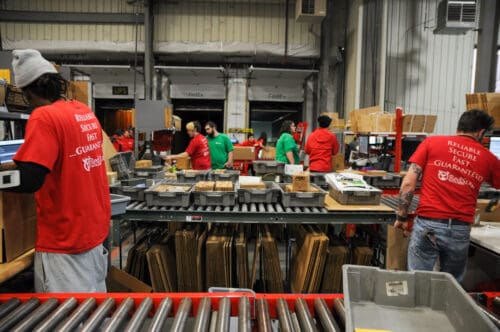Managing and optimizing a local or global supply chain is one of the most important activities an ecommerce business or online seller can do if they want to control spend and put themselves in a position for growth.
What is Supply Chain Optimization?
Supply chain optimization helps control your costs and other resource usage. Supply chain management and optimization is a mindset that extends beyond your product fulfillment center or distribution warehouse, it connects manufacturers and carriers to warehouses and third-party logistics companies, and then retailers and final customers. Getting it right allows you to share data and make decisions quickly, while everyone can serve as a partner to boost sales and performance of the team. Every industry can benefit and so can every company at any location in a supply chain.
How do you optimize a supply chain?
Understanding how to manage your supply chain optimization begins with learning where to start. As fulfillment experts, we always start with getting products to customers. Once you can do that easily and affordably, it’s possible to work your way back upstream and continually optimize each tier of your supply chain. So, let’s begin with those warehouses and shipping zones and then move on to other best practices:
1. Plan around shipping zones and warehouse locations
When many companies approach optimizing your supply chain, they’re really interested in controlling costs. So, supply chain management optimization shifts to better allocating spending. In the fulfillment world, we’re talking about working with multiple warehouses and strategic locations to reduce shipping zones.
Review where your customers and partners live and seek out central locations that can help reduce your cost per order. Red Stag Fulfillment, for example, has multiple U.S. warehouses so that we can reach more than 99% of the country within a few days. Nearby locations keep carrier costs down while still giving access to fast delivery times.
You can do the same by shifting to a central location for your fulfillment. Having multiple warehouse locations and spreading inventory across them is a simple but effective way to minimize those costs and you can quickly reach a positive ROI even with the added labor.
There’s a secondary advantage that’s just as important. When you have multiple distribution locations, you’re less likely to experience a business disruption that completely halts fulfillment. If one site goes down, the other can pick up the slack and fill all orders. Customers won’t notice the disruption and you keep revenue flowing, while giving yourself time to properly address any site concerns. It’s a smart business decision that ultimately helps you control costs and yields optimization of time, demand planning, and labor efficiency.
2. Outsource non-core activities like fulfillment
Few companies get into business for the purpose of fulfillment. It’s one of those additional functionalities that leadership knows enough to ship things but may not understand how to optimize and increase efficiency. It’s a secondary focus.
That’s why roughly 46% of companies outsource their order fulfillment to someone like Red Stag Fulfillment. We’re the experts who know how best to fill an order and keep a customer satisfied. That covers everything from selecting the proper packaging and shipping to choosing smart carriers, optimizing labor, and leveraging our volume for shipment discounts.
Plus, fulfillment partners can do things that your warehouse may struggle to complete. Our most common supports include providing product assembly and kitting services, managing returns, verifying addresses before goods are sent, and having enough physical space for you to add SKUs, increase inventory, or try something new.
Year-end demand planning doesn’t have to strain your warehouse or staff because our expertise is about knowing when and how to scale to avoid operational issues.
Manufacturing, sourcing, customer service, inventory management, and global business planning can also be outsourced to benefit your business. Match outside expertise to your needs and better support important company activities.
3. Reconfirm supplier and retailer communication
Optimized supply chains need two-way communication between you and your suppliers as well as retailers or other end customers. Share information and work with communications tools that can automate messaging and data when possible.
Communicating early and often can help you and your suppliers understand overall demand, allowing you to quickly scale up or down orders. If you ever need to rush an additional production round, this data sharing can give them a heads up to protect your operations. It’ll also protect you by diversifying raw materials suppliers who need to know your demand and may have different lead times.
Talking helps you avoid confusion and mistakes, too. If you’re transparent about needs, your partners are better able to flag potential issues. At the same time, retailers that provide data can help you start to predict trends in consumption to help you adapt your overall supply chain to end consumers.
Look for software that makes it easy to communicate directly as well as automate data sharing.
When you get communication down, you’ll have an easier time employing advanced inventory techniques such as just-in-time fulfillment and handling backorders. It’s a smart part of your business plan and helps you find the right service partners and resources.
4. Utilize leading technologies
Beyond communication platforms, there are many other technologies you should invest in to support your supply chain management.
There are small tools that can help your business in any warehouse. Mobile devices and barcode scanners can help you track inventory and improve order accuracy, for instance. Scanning allows you to track goods as they move throughout the entire warehouse process, from receiving as an inbound shipment to order fulfillment and outbound shipments. The same tech can track how you use carts, trucks, forklifts, and other equipment to ensure things are maintained and repaired regularly.
Data exchanges in your platforms allow sales and order management tools to speak with warehouse tools, speeding up order processing and fulfillment. With a robust solution, you can combine orders from every source into an omnichannel solution that gives warehouse teams and inventory counters a single list to use.
Centralizing management software also helps you use internal data to best manage every part of your operation. When you’re connected, data is no longer siloed and you can apply analytics to spot trends in demand or cost concerns, optimize labor, reduce overhead costs, and even look for opportunities based on sales and marketing.
In the logistics world, if you measure it, you can maximize it.
5. Create a path forward together
Some events stick with a supply chain for a lifetime. The COVID-19 pandemic is perhaps the biggest lesson we’ve faced in recent memory and it has reminded supply chains around the globe that they need to prepare and plan ahead. Know how you get to where you need to be. Create redundancies to get there. Have the communication to monitor and understand when you need to switch.
Make your path to ensure order fulfillment regardless of what the world throws at you.
That’s easier said than done, and much of it depends on your partnerships and relationships. Treating your people and partners well is a smart first step. You’ll need the right team to accomplish this and all the other steps we’ve listed. It’s how you boost performance and efficiency.
The news most companies like to hear is that you’re never in it alone. Supply chains are long partnerships. So, you might have Red Stag Fulfillment’s multiple warehouses to reliably get your goods to customers, or partnerships like multiple manufacturers to ensure you never run dry. Work together and you grow together.
Ask for the help you need
If you need help, we’re just an email away. Our mission is to be of assistance even if we’re not the right fit.
We support supply chain optimization practices because we’ve seen how they improve customer service, inventory management, and decision making. From raw materials and production through ecommerce business and final distribution, optimizing processes allows you to run better and more affordably.
Supply chain optimization is a smart business management tool designed to make the most of your resources. But, you might not always know how to achieve those performance gains or when to make manufacturing part of these conversations, for example. Partners and software can help point you to better processes understanding and demand planning. Your entire supply chain wants you to do better because it helps them do well, too.
So, ask for the help you need. And it may come back around, so help your partners and customers who ask too. Optimizing your supply chain is always business best done together.











